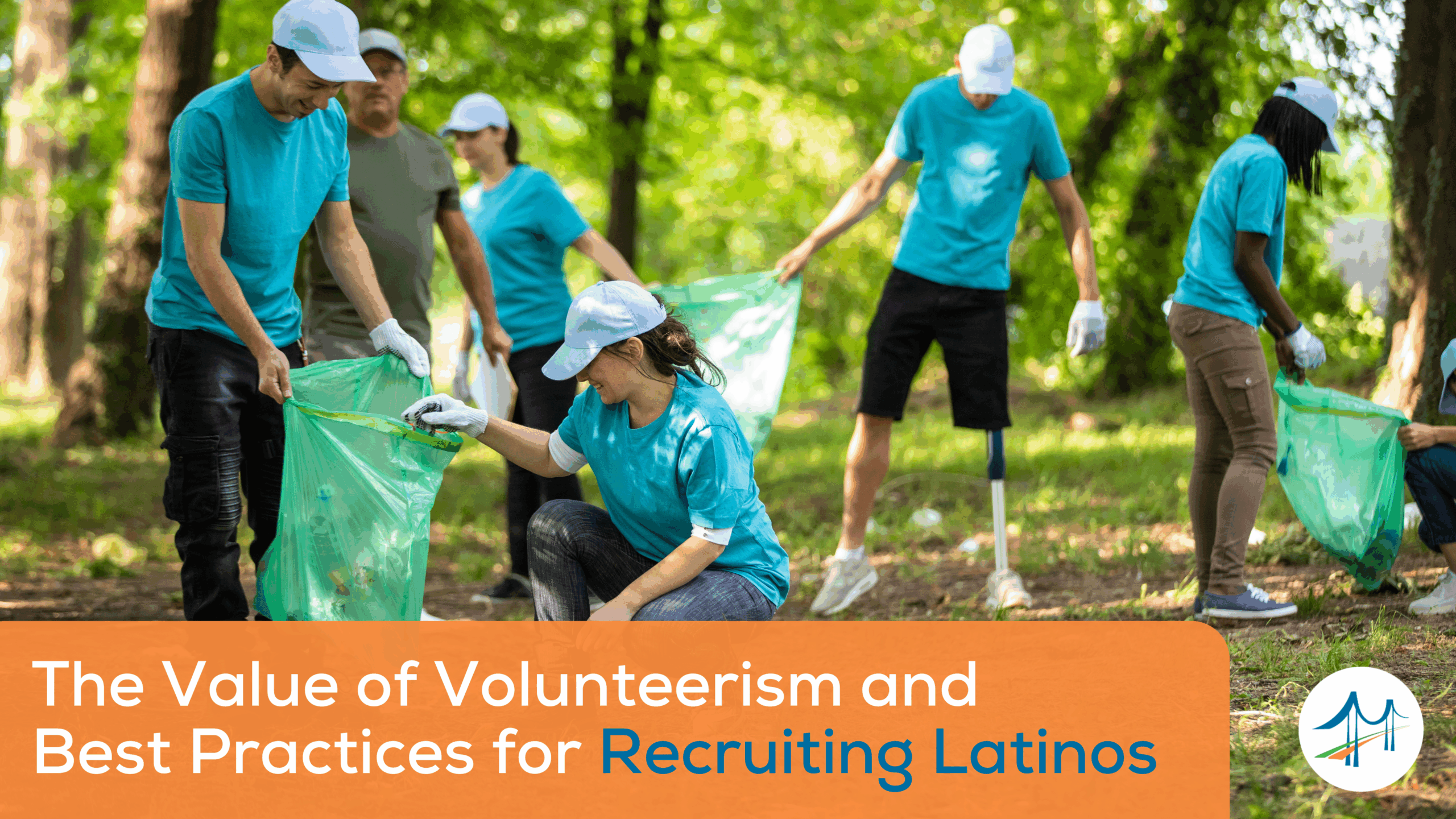
We spend about 30% of our lives sleeping and approximately 17% of our lives working—together that’s nearly half of our lifespan! Hopefully we spend the other half enjoying time with loved ones, traveling, playing, learning, and doing other things that contribute to a fulfilling life. But what about community involvement? Giving back is important, and there are many ways to do so beyond just donating money—what about investing your time, energy, effort, or knowledge?
From strengthening communities to improving mental health for individuals, volunteering offers an array of benefits. Yet according to the U.S. Bureau of Labor Statistics, only about a quarter of adults in the U.S. spend time volunteering, and of these 62.6 million individuals, only 15.5% are Hispanic.
Latinos represent a valuable resource for organizations to tap into. Hispanics made up more than half of total U.S. population growth over the last decade, according to the Pew Research Center. How can we increase community engagement, and why is it important?
The Benefits of Volunteering
One obvious benefit of volunteering is the impact you have on the lives of others—within your local community or beyond, depending on how you choose to contribute. But being of service doesn’t just benefit others—it also has a positive impact on you!
Volunteering can give us a sense of greater purpose—humans are hardwired to help others, and doing so naturally raises serotonin levels and thus boosts our mood, according to the Cleveland Clinic. It also makes us more empathetic as we are confronted with the realities and lives of other people, and we are given a chance to put ourselves in their shoes. Additionally, volunteering provides an opportunity to connect with others and build relationships, which can help prevent stress and depression.
Volunteerism could even advance your career! By getting out in the community, you can expand your network, potentially leading to employment opportunities. Furthermore, it allows you to build upon your skillset or test out a new industry and gain experience. From your impact on others to enhanced mental health and career growth opportunities, the benefits of volunteering are abundant.
Best Practices to Recruit Latino Volunteers
In order to increase involvement from the Latino community, it is important for mainstream organizations to understand how Latinos view volunteering culturally and what factors hinder them from participating. Then they can begin to evaluate how to adjust outreach and recruitment strategies in order to implement culturally responsive practices.
Build Trust and Understand Latino Culture
A key element to attracting Latino volunteers is building a foundation of trust in their community. Engage with Latino businesses, and if possible, partner with organizations that are established and respected in the Latino community. Take time to learn about Latinos’ traditions, beliefs, and values, and always be mindful of these distinctions. While having Latinos on your outreach team is certainly helpful, this does not have to be a limiting factor. It’s beneficial to have bilingual or bicultural outreach staff, but what’s most important is for them to be able to relate to Latinos. At the very least they should be culturally competent and able to acknowledge, appreciate, and accept cultural differences. Building trust within a community takes time, so be patient, persistent, and don’t expect results overnight.
Consider Terminology
In Latin America, there is not the same culture and language around volunteering as in the U.S.–it is typically associated with the wealthy, and thus isn’t generally within the realm of the Latino experience. However, that’s not to say that it’s not culturally prevalent for Latinos to be selfless—quite the contrary. For Latinos, helping others tends to be a core value, starting within the family, among friends, or through the church. Latinos are characteristically altruistic—but they need to feel personally connected to the cause. You can better connect with the Latino community by using personal language to describe the need for volunteers. A study by Oregon State University suggests using the term “help” instead of “volunteer,” and using personal stories to give context, which allows potential volunteers to directly identify with the cause.
Outreach Methods
Extending personal invitations was found to be a much more successful method for recruiting Hispanic volunteers as opposed to generic announcements through flyers. Approach people directly and ask for their help with specific assignments. Using Spanish radio programs has also proved to be fruitful—according to a report by Nielsen, radio continues to be the media category with the highest reach among U.S. Hispanics ages 18 and older. If informational meetings for potential volunteers are part of your organization’s outreach strategy, make them family-friendly social events, as Latinos are family-oriented and often attend events in numbers. Offer food or beverages if your budget allows—this sign of hospitality will make Latinos feel welcomed. Holding meetings in Spanish will also greatly increase the potential for participation from the Hispanic community. Additionally, Latino culture is naturally cooperative, so emphasize opportunities for work that can be done in teams, and the Latinos you successfully recruit will likely bring friends and family along.
Ongoing Support and Cultural Competency
While engaging Latino in volunteer activities, provide adequate training—preferably in the form of demonstration, as opposed to written instructions, in order to absolve any barriers due to literacy or language differences. Whenever possible, limit and simplify paperwork. If forms are necessary, make sure to explain why and offer support for filling them out, as Latinos can be quite skeptical of sharing their information and how it will be used.
Many Latinos work multiple jobs or fill roles that require them to be at work in the evenings or on weekends. Try to offer flexibility for meetings and scheduling in order to accommodate this. Often, Latinos in the U.S. face economic barriers, so limit personal expenses associated with volunteering, and try to offer transportation to and from activities.
When it comes to appreciation and recognition, avoid situations that would force your Latino volunteers to be the center of attention in front of a large group of people, as this could make them uncomfortable. Consider a certificate or a celebratory gathering.
Ready to Tap into the Power of Latinos?
For organizations to strengthen their programs by leveraging the Latino segment of the population, they must first consider cultural differences and re-evaluate outreach strategies. Once Latino volunteers are onboarded, it is vital to continue to emphasize cultural competency throughout the organization in order to retain them.
April is National Volunteer Month—the perfect opportunity for organizations to begin expanding outreach efforts, diversify their volunteer base and tap into the untapped Latino community.
Image source: Environmental Volunteers by miodrag ignjatovic from Getty Images Signature

